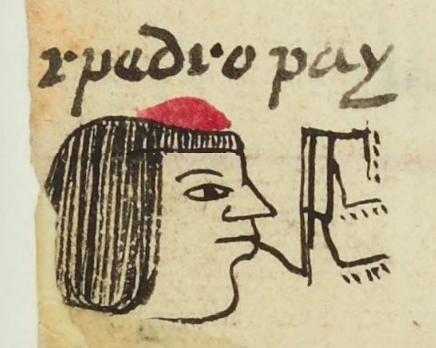Pain (MH591v)
This black-line drawing of the compound glyph for the personal name Pain (“He Ran Fast,” attested here as a man’s name) shows a bird's eye view of three alternating footprints (which here stand for the verb paina, "to run fast." To help us know which of the many possible readings of footprints are meant, the scribe has added a flag (panitl), which is a near homophone. The flag is shown with the banner to the right of the staff.
Stephanie Wood
Footprint glyphs have a wide range of translations. In this collection, so far, we can attest to yauh, xo, pano, -pan, paina, temo, nemi, quetza, otli, iyaquic hualiloti, huallauh, tepal, tetepotztoca, totoco, otlatoca, -tihui, and the vowel "o." Other research (Herrera et al, 2005, 64) points to additional terms, including: choloa, tlaloa, totoyoa, eco, aci, quiza, maxalihui, centlacxitl, and xocpalli.
Stephanie Wood
pedro pay
Pedro Pain
Stehanie Wood
1560
Jeff Haskett-Wood
icximachiyotl, xocpalli, icxipamitl, feet, steps, pasos, footprints, huellas, flags, banderas, banners, correr rápido, nombres de hombres

paina, to run fast, https://nahuatl.wired-humanities.org/content/paina
pan(itl), flag or banner, https://nahuatl.wired-humanities.org/content/panitl
Corrió Rápido
Stephanie Wood
Matrícula de Huexotzinco, folio 591v, https://www.loc.gov/resource/gdcwdl.wdl_15282/?sp=262.
This manuscript is hosted by the Library of Congress and the World Digital Library; used here with the Creative Commons, “Attribution-NonCommercial-ShareAlike 3.0 License” (CC-BY-NC-SAq 3.0).



